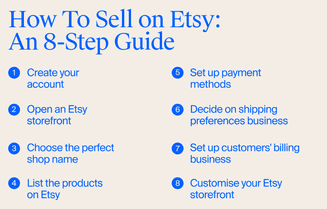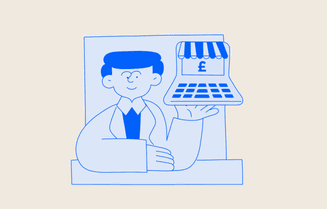How To Sell on Etsy: An 8-Step Guide
- Modified: 26 December 2024
- 11 min read
- Ecommerce


Gabi Bellairs-Lombard
Author
Gabi is a content writer who is passionate about creating content that inspires. Her work history lies in writing compelling website copy, now specialising in product marketing copy. Gabi's priority when writing content is ensuring that the words make an impact on the readers. For Osome, she is the voice of our products and features. You'll find her making complex business finance and accounting topics easy to understand for entrepreneurs and small business owners.
Interested in learning how to sell on Etsy? Our straightforward guide simplifies the process, breaking it down into eight achievable steps. Whether you’re new or looking to fine-tune your shop, we cover everything from opening your storefront to strategic selling tips and a breakdown of the costs involved. By the end, you’ll have a clear road map for confidently becoming a successful Etsy seller.
Starting an Etsy store has become a popular option for many, especially creatives, since it does not require a physical shop location but allows sellers to make money from the handmade goods they create or source from the comfort of their homes.
Key Takeaways
- Setting up an Etsy store involves a user-friendly 8-step process, which includes account creation, shop setup, listing products, and customisation of the storefront, along with establishing payment and shipping preferences via Etsy Payments.
- Sellers need to be aware of the costs associated with selling on Etsy, including listing fees, payment and transaction processing fees, and currency conversion fees, to efficiently manage finances and pricing strategies.
- Successful selling strategies on Etsy encompass effective marketing, well-crafted product descriptions, proactive customer service, and use of analytics, with tips including leveraging social media, email marketing, and optimising product listings with tags and categories.
How To Sell on Etsy in 8 Steps
Setting up an Etsy shop is a straightforward process, designed to be manageable even for those who are new to online sales or have an existing ecommerce website. From selling vintage items to homemade goods, the platform offers a variety of tools and resources to help you create an engaging and successful Etsy storefront.
If you need assistance with managing your ecommerce accounting or require guidance on online business registration, our team is here to help. We specialise in supporting entrepreneurs like you in navigating the intricacies of online business operations and ensuring compliance with regulatory requirements.
Here are the eight key steps to embark on your Etsy selling journey.

1 Create your account
Initiating your Etsy selling journey begins with creating an Etsy account. This account not only allows you to run your Etsy shop but also offers the opportunity to buy from other sellers on the platform.
Once your account is set up, adding a profile picture and bio to present yourself to the Etsy community is a beneficial next step. This helps build a connection with potential customers and gives your shop a personal touch.
For security, Etsy requires two-factor authentication, with verification codes received via an authenticator app, SMS, or phone call.
2 Open an Etsy storefront
The process to launch your Etsy storefront is user-friendly and intuitive. Etsy provides a range of resources to assist sellers, including:
- The Seller Handbook
- Etsy Success podcast
- YouTube videos
- Etsy U classes
You’ll need a desktop web browser to set up your shop initially, but managing it thereafter can be handled via the Etsy Seller app.
The platform encourages sellers to use the “Shop Manager” tool to manage:
- Listings
- Orders
- Marketing
- Stats
- Finances
Remember to review Etsy’s Prohibited Items Policy to ensure your items comply with sale regulations.
3 Choose a suitable shop name
Selecting a fitting shop name is pivotal because it embodies your brand identity and merchandise on Etsy. Your store name should:
- Be creative
- Be memorable
- Reflect your brand
- Accurately describe your products
- Be unique
The name can be a reflection of the products sold, an abstract name, or even your own name for a personal touch.
Remember that Etsy allows sellers to change their shop name multiple times before going live and up to five times after opening the shop.
4 List the products on Etsy
Populating your shop with product listings is a significant part of the setup process. Each item can be accompanied by up to 10 photos to showcase the product from various angles and in different contexts. High-quality visuals significantly impact Etsy shoppers’ purchase decisions by highlighting the unique features and quality of the products. Sellers also have the option to add a short video to provide a dynamic visual representation of their products.
Be sure to list your products under niche and accurate categories such as jewellery, paper and party supplies, craft supplies, handmade items, and wedding products to increase profits. Also, bear in mind that many shoppers will use the Etsy app to sell their goods so your product listings need to be optimised for mobile.
5 Set up payment methods
Establishing your payment methods is another vital stage in setting up your Etsy shop, which needs to be done before you start selling. Here are the steps to follow:
- Connect a payment account, such as a bank account, to receive buyer payments.
- Add a debit or credit card to facilitate paying Etsy bills.
- Etsy verifies linked credit and debit cards by making micro-transactions to ensure the cards are active and valid for use on the platform.
As your business evolves, you can add additional payment and billing options, including Apple Pay, through Etsy’s Shop Manager under the Finances section.
6 Decide on shipping preferences
Determining your shipping options is a significant step towards in finalising your Etsy shop. Etsy’s Postage Calculator and delivery profiles assist sellers in determining rates and managing uniform postage rates. You can offer free shipping for multi-item purchases or a discount, as well as options for expedited shipping at an additional cost and even free shipping to entice buyers.
Don’t forget to add shipping rates for each desired destination country, as many buyers only see listings that ship to their location.
7 Set up customers' billing
Configuring customers’ billing is a simple task for an Etsy shop owner. The platform supports various payment options and local currencies through customers' Etsy Payments. This ensures a seamless and secure buying experience for your customers, which is crucial for maintaining customer satisfaction and building a trustworthy relationship. Etsy Payments also allows customers to pay for your products with a payment method of their choosing while you receive your payment directly to your chosen bank account.
8 Customise your Etsy storefront
Tailoring your Etsy storefront marks the final stage of your shop’s establishment on the platform. The visual identity of your store is the first impression that customers get, so it’s crucial to make it count. Key aesthetic elements like fonts, colours, and high-quality photography establish an attractive Etsy store, catering to the diverse shop preferences of potential buyers.
Free online tools such as Canva can be used for the graphic design needs of your store, allowing you to craft appealing store banners and an attractive brand aesthetic.
How Much Does It Cost To Sell on Etsy?
Selling on Etsy comes with a few costs that sellers should be aware of. Understanding these costs can help you better manage your shop’s finances and develop effective pricing strategies for your products.

Listing fees
When adding an item to the shop on Etsy, there is a listing fee of $0.20 for each one. This fee is charged to the seller when the item is listed. This fee is standard, regardless of the quantity or price of the product. The listing fee is an important consideration when pricing your products, as it directly impacts your profit margins.
Transaction fees
In addition to Etsy fees, such as listing fees, Etsy also charges a transaction fee. This fee is 6.5% of the total order amount, which includes the item cost, shipping, and packaging. The transaction fee is another cost to factor into your pricing strategy.
Payment processing fees
Payment processing fees are another cost that Etsy sellers need to be aware of. These fees are a set rate plus a percentage of the total sale price and vary by country. They are charged in addition to the transaction fees, increasing the total cost of selling on Etsy.
Currency conversion fees
Currency conversion fees apply when the sale’s currency differs from the bank account’s currency. Etsy charges a fee of 2.5% above the daily exchange rate for this service. Additionally, regulatory operating fees may apply and vary by country.
Additional fees
Other additional fees include auto-renew sold fees for automatically reposted listings, multi-quantity listing fees for variations, and private listing fees for specific buyers.
To further promote either your Etsy store or specific products, many have been successful using Etsy Ads which allows you to highlight your brand and products in specific Etsy search results. However, this is an extra cost that you need to factor in.
Shipping and gift wrap fees are also important considerations, as personalised gift wrapping and hand-written notes are proven methods to impress your customers.
Additionally, running an Etsy store is essentially running an online business, and this comes with its own attachments. If you become profitable, you may need to consider ecommerce accounting so that you don't become distracted by financial admin instead of continuing to grow your online store.
Grasping all the expenses linked with Etsy selling is vital for devising successful pricing tactics and profit estimations.
Top 10 Tips for Successful Selling on Etsy
Once your Etsy shop is set up, there are several strategies you can implement to increase its success. These include:
- Various marketing strategies
- Crafting compelling product descriptions
- Managing returns and refunds effectively
- Providing excellent customer service
Here are the top 10 tips for successful selling on Etsy.
1 Social media marketing
Social media is an instrumental platform for advertising your shop on Etsy. A comprehensive social media marketing plan should include consistent posting schedules across platforms such as Instagram, Pinterest, and Facebook to engage niche audiences and effectively showcase products. Utilising Etsy ads can further enhance your shop’s visibility and reach.
Interacting with potential customers through Facebook groups, engaging video content, and giveaways increases brand awareness and customer engagement.
2 Content marketing
Another potent tactic to captivate and engage customers is content marketing. By creating valuable content, like blog posts, guides, and videos related to your products, you provide value to potential customers. This not only builds trust but also keeps your brand at the top of their minds when they’re ready to make a purchase.
It's important for you to also make sure you're tracking the results of these efforts. You can optimise your marketing strategy by setting up realistic KPIs and metrics for ecommerce businesses.
3 Email marketing
Cultivating an email list and disseminating newsletters, updates, and promotions is a tried-and-true method for boosting customer loyalty and sales. Direct communication with your customers allows you to keep them updated about your latest products, provide personalised content, and foster a more engaged customer base.

4 Craft compelling product descriptions
Composing engaging product descriptions is essential for successful sales on Etsy. Here are some tips to help you create effective product descriptions:
- Include clear, informative details about the product.
- Provide precise measurements to give buyers a better understanding of the size.
- Articulate various set options, if applicable, to support buyer decision-making.
- Highlight any added bonuses or free items that come with the product.
- Suggest products as ideal gifts for special occasions to enhance perceived value and expand the audience.
By following these tips, you can create compelling product descriptions that will help drive sales on Etsy.
5 Manage returns and refunds
Effective management of returns and refunds is key to sustaining a favourable rapport with your customers. Make sure your return policy is clear to prevent any misunderstandings. If a dispute arises, always follow the procedures outlined in Etsy’s Help article on how to manage these cases.
Ecommerce accounting needs to be an integral aspect of your business, especially as it scales. You can learn more about this aspect of running a business in our guide to ecommerce accounting.
6 Have a unique About Me section
Creating a unique About Me section helps connect with your customers on a personal level. This section should include:
- A brief introduction to the brand
- Background story
- Mission
- Values
- A glimpse into the creative process behind the products.
Sharing your expertise and experience can build trust and differentiate your shop from competitors.
7 Respond to customer inquiries
Quick, professional responses to customer inquiries are vital to upholding a positive customer relationship. Allocate specific times each day for responding to inquiries to boost customer communication.
Utilise an auto-reply message to manage customer expectations regarding response times, especially during busy periods.
8 Encourage reviews and feedback
Encouraging reviews and feedback from customers is an effective way to build social proof, which can significantly influence buyer decisions and improve your store’s visibility. You can include hints or reminders in your packaging as an indirect request for customers to leave a review.
However, avoid pressuring buyers into leaving reviews, as it can create discomfort and may even lead to negative feedback.
9 Product photography tips
Effective product showcasing necessitates high-quality product photography — this is probably one of the most important considerations when looking to sell your products on Etsy. The quality of your photos has been said to trump shipping costs for buyers' decision-making, so don't take any shortcuts here! Here are some tips to keep in mind:
- Photograph in natural light to avoid harsh shadows
- Ensure images are in sharp focus
- Avoid using digital zoom; instead, physically move closer to or further from the product.
Following these tips will help you capture the best images of your products.
Capture multiple images in various environments to find the most suitable setting that highlights the product’s features and include different types of shots to showcase the product in multiple contexts and uses.
10 Use tags and categories wisely
Smart use of tags and categories can enhance your Etsy shop’s search optimisation, thus boosting its visibility in Etsy search results. Incorporate long-tail keywords in tags to target specific and less competitive search queries. Ensure that tags are highly relevant to the product to prevent poor conversion rates and potentially negative reviews.
Updating tags and titles seasonally or for events such as holidays can help items appear in relevant searches during high-traffic shopping times.
Summary
In conclusion, selling on Etsy offers a unique opportunity for small business owners to showcase and sell their handmade, vintage, and craft supplies. By following these steps and tips, you can set up a successful Etsy shop and start selling your unique products to customers worldwide. So why wait? Start your journey on Etsy today, and let your creativity flourish!






